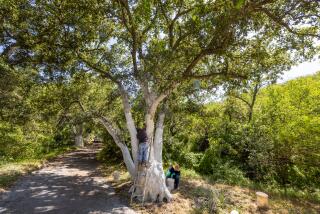Eucalyptus Pests Are a Sticky Matter
- Share via
Question: My eucalyptus trees have an infestation of red-gum psyllids. These are nasty little suckers that live under some type of shell on the leaves. The bugs cause a lot of defoliation, and their shells drop everywhere. What can I do?
--J.G., Menifee
Answer: It used to be that eucalyptus were one of the few pest-free trees in California, but several insects have arrived from their native Australia to change that. The redgum lerp psyllid (RLP for short or Glycaspis brimblecombei) is the latest and perhaps the worst. It was discovered in June of last year but is already a serious pest up and down the state (as The Times reported July 29 in its Metro section).
There’s no mistaking it, because there are no other leaf-covering, sucking pests of eucalyptus, and because the nymph stage lives under a distinctive “lerp.” The conical lerps look a lot like the armor of a scale insect but are temporary shelters made by the nymph from crystallized honeydew secretions. Sometimes lerps and leaves are covered with green or black sticky mold that grows on the secretions.
Often the lerps rain down from the trees as they are abandoned. The nymphs also can dribble honeydew on whatever is below the tree. Adult psyllids look similar to light-green leafhoppers, but only their bodies are green; the wings are clear.
Lerp psyllids are sucking insects and are found only on eucalyptus. The magnificent redgums, E. camaludensis, are their favorite host, but they’re also found on lemon gums, sugar gums, red ironbark, E. nicholii and others.
It’s a tough pest to control. Only partly in jest, entomologist Harold Mitchell, of Mitchell Pest Control in San Gabriel, was asking people who called about the psyllid “where they wanted us to pile the firewood.”
In his 50 or so years in the pest control business, Mitchell says, he’s never seen anything take hold so quickly.
Professionals using a systemic like Merit can spray for psyllids, but tree size and location may make spraying impractical or impossible. Mitchell is also trying this systemic as a soil drench that is taken up by the tree, and he is studying the results.
Homeowners can do little themselves other than keep trees healthy through the dry summer by occasional deep watering. Don’t overdo it--a wet soil can be just as harmful as one that is too dry. Keep water away from the trunk, and don’t fertilize. If the tree is small enough, homeowners can try spraying insecticidal soap and horticultural oils.
The psyllid can defoliate trees. If it does so often enough, the tree may not have the energy to recover. If a tree becomes too stressed, the other recent pest from Australia--the eucalyptus longhorned borer--will get into the tree and kill it.
The eventual solution will almost have to be biological, since the trees are so big and often in public spaces. Some local ladybugs and lacewings prey on this psyllid, but a search will be made in Australia for more effective predators.
*
Q: As soon as the figs on my tree begin to ripen, ants discover the fruit and crawl up the tree to feast on the bounty. Is there a way to prevent the ants from getting at the fruit without using poison?
--D.S., La Crescenta
A: Absolutely. Use a time-tested product called Tree Tanglefoot or one called Stickem--sticky substances you apply to the bark near the base of the tree, in bands wide enough to halt the pillaging ants.
The ants will try to cover the sticky stuff--sacrificing their own bodies if need be--so they can continue their foraging. You must keep disturbing the surface to keep it tacky. Dust can also coat the surface over time.
Both products can harm the bark of young trees. So it is a good idea to apply the sticky stuff to tree wrap or a tree collar and not directly on the bark if the tree is young.
On older trees, the product can be spread directly on the bark. Make sure there is no other avenue into the tree--don’t let branches touch the ground, fences or walls.
Tanglefoot is usually easy to find at nurseries. It, along with tree wraps and other products, can be ordered from Peaceful Valley Farm Supply, P.O. Box 2209, Grass Valley, CA 95945, (888) 784-1722, https://www.groworganic.com.
*
Smaus’ column is published Thursdays. Write to Robert Smaus, SoCal Living, Los Angeles Times, Times Mirror Square, Los Angeles, CA 90053; fax to (213) 237-4712; or e-mail robert.smaus@latimes.com.






